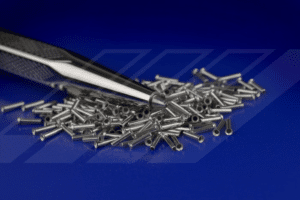Gold Plating of Micro Components
Gold plating of micro-components such as those used within the medical and interconnect industries presents unique plating challenges. Many micro-component surface treatments, whether being gold plated, silver plated or even passivated corrosion-resistant alloys require specialized process tooling and processing techniques to ensure plating finishes are uniform across all functional surfaces. The cleaning, processing, rinsing and drying processes must all be engineered around the characteristics of the micro component.
Prior to developing micro-compatible processes, plating techniques were limited to significantly larger components on a more macro-scale. Opportunities to expand services within the medical and interconnect industries was the business driver that pushed Advanced Plating Technologies (APT) to focus on process development for substantially smaller micro-components.
Specialized Techniques in Gold Plating
Our processes-specific development of cleaning, plating and rinsing techniques for micro parts came from our work within industries such as the medical industry. Numerous applications required our engineering group to search out new tools and develop methods and techniques to handle smaller and smaller parts. Most of the techniques we have developed have been from good old fashioned R&D coupled with some trial and error. We also have a very good cadre of preferred vendors and suppliers with technical resources that help amplify our own in-house resources. We often select our vendors based upon their technical resources and ability to help our company push techniques and processes further.
The challenges in gold plating micro-components often lies in the boundary-layer effect of fluids. Any fluid that comes into contact with a solid has a boundary layer in which the liquid wants to remain in contact and static with the solid surface. As the parts get smaller and smaller, there is a higher ratio of surface area to the overall volume of the part which results in a stronger boundary-layer effect per piece. In addition, many micro parts used in the medical and telecom parts are tubular components such as eyelet funnels or female interconnect sockets. These components act as micro-straws that want to hold solution at the surface rather than rinse it.
Plating processes employ numerous aqueous solutions including hot alkaline cleaners, various acids used for deoxidizing and activating as well as acidic, alkaline and cyanide-bearing plating solutions. Nearly all process solutions have specific gravity greater than 1.0 meaning that they are more viscous than water with an increased surface tension. This characteristic further amplifies the boundary layer effect within the processing solutions. If the preceding solutions are not adequately removed from the surface of the parts, it can cause failure in the subsequent step.
The engineering group at APT recognized that overcoming the boundary layer effect was key in developing successful plating processes for micro components. Use of ultrasonic generators, proprietary mechanical agitation techniques, thermal cycling during processing and extensive specialized hot deionized rinses are all integral to APT’s successful processing techniques. In addition, APT has invested heavily in inspection equipment required to inspect deposits such as gold plating of micro parts. X-ray spectroscopy with ultra-fine collimators that allow focusing of the x-ray beam as small as 0.004 inches are a good example of the type of equipment used in the inspection of gold plated micro parts.
Contact a member of our Technical Sales Team for more information on APT’s Gold Plating Services.
By M. Lindstedt








